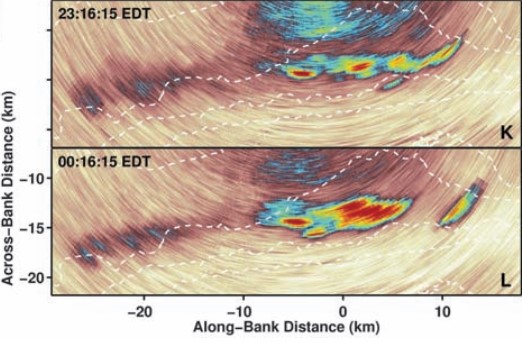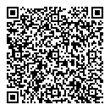2023年07月06日(木曜)
海洋未来イノベーション機構シンポジウム 水産資源調査のゲームチェンジング技術~海洋音響導波路リモートセンシング~
従来の水産資源調査で多用されている魚群探知機の有効距離は数十mから最大数百mまででした。
米国マサチューセッツ工科大学で開発された「海洋音響導波路リモートセンシング(OAWRS: Ocean Acoustic Waveguide Remote Sensing)」は、浮魚類の群れを半径60kmの範囲で気象レーダーのように可視化できる画期的な技術です。魚群探知機の超音波に比べはるかに低い魚のウキブクロの共振周波数を使い、広大な範囲での浮魚資源をリアルタイムで画像化し、分単位で魚群密度分布図を更新できます。
また、自ら音声を発する鯨類であれば100-200kmの範囲での検知、トラッキング、分類ができます。同様に魚類が繁殖期に発する鳴音の検出も可能でしょう。多獲性浮魚資源の漁獲海域にこの技術を導入すれば、探索の手間が省け、効率的に漁獲できるだけでなく、資源の現況にあわせたきめ細かい順応的管理も可能になると考えられます。
同技術を開発したNicolas Makris教授とPurnima Ratilal Makris教授をお迎えし、長崎県の水産業で行われているような多様な水産資源管理への本技術の応用について議論します。参加は無料ですが,事前の申し込みが必要です。奮ってご参加ください。
 米国東岸でOAWRSにより観察されたニシン魚群の例. 出典Makris, N. C. et. al., (2009). Critical population density triggers rapid formation of vast oceanic fish shoals. Science, 323(5922), 1734-1737. |
【日 時】2023年7月6日(木)10時~12時(日本時間/JST)
【会 場】長崎大学 文教キャンパス 文教スカイホール(定員200名)
https://www.nagasaki-u.ac.jp/ja/access/bunkyo/
※席に限りがあるため,下記URLまたは二次元コードから7月3日(月)正午までに事前申込みをお願いいたします。申し込み無しでもお越しいただけますが,定員に達した場合にはお断りさせていただく場合がありますので,ご了承ください。
| 【申し込みURL】 https://forms.gle/9yp3qDx6pPtYscf16 |
【二次元コード】 |
※同時通訳は行いませんが,発言内容の概要を日本語で伝えたり,日本語の質問やコメントを英語で伝えるお手伝いは行います。
【テーマ】
水産資源調査のゲームチェンジング技術~海洋音響導波路リモートセンシング
Game-changing technology for fisheries resource surveys
- Ocean acoustic waveguide remote sensing
【プログラム】
[登壇者]
開会挨拶:坂口 大作(長崎大学 海洋未来イノベーション機構 副機構長,工学研究科長)
趣旨説明:松下 吉樹(長崎大学 海洋未来イノベーション機構 海洋未来科学推進室長)
パネルディスカッション「超広域水産資源モニタリング技術の応用」
Nicolas Makris(マサチューセッツ工科大学教授)
Purnima Ratilal Makris(ノースイースタン大学教授)
赤松 友成(笹川平和財団海洋政策研究部長)
広瀬 美由紀(長崎大学准教授)
進行:松下 吉樹(長崎大学 海洋未来イノベーション機構 海洋未来科学推進室長)
【問い合わせ先】
海洋未来イノベーション機構 海洋未来科学推進室長
水産・環境科学総合研究科 教授
松下 吉樹
yoshiki*nagasaki-u.ac.jp(*を@に変更して下さい)
Game-changing technology for fisheries resource surveys - Ocean acoustic waveguide remote sensing
The effective distance of the fish finder, which is often used in conventional fisheries resource surveys, ranges from several tens of meters to several hundred meters at maximum. "Ocean Acoustic Waveguide Remote Sensing" developed at the Massachusetts Institute of Technology in the United States, is an epoch-making technology that enables weather radar-like visualization of schools of pelagic fish which has been demonstrated out to radii of roughly 60 km. It uses the resonance frequency of fish swim bladders, which is much lower than the ultrasonic sounds used by fish finders, to image pelagic fish resources over vast areas in real time, and make minute to minute updates of areal population densities. The technology also has been demonstrated to detect, track and classify cetaceans that emit their own sounds out to ranges between 100-200 km, as well as the local sounds fish shoals emit during the breeding season. If this technology is introduced to the fishing grounds of pelagic resources, it will not only save the searching time of target shoals and aid efficient capture, but it will also enable adaptive management of fish resources referring to the current status of the biomass distributions, and spatio-temporal quantification of behavioral dynamics.
At this symposium, we welcome Professor Nicolas Makris and Professor Purnima Ratilal Makris, who developed this technology, and will discuss the application of this technology to the management of various fisheries resources.
[Date & Time].
July 6, 2023 (Thursday) 10:00 a.m. - 12:00 p.m. (Japan Standard Time/JST)
[Venue]
Bunkyo Sky Hall, Bunkyo Campus, Nagasaki University (Capacity: 200 people)
https://www.nagasaki-u.ac.jp/ja/access/bunkyo/
Please register in advance by noon on July 3 (Mon.) via the URL or QR code below as seats are limited. You can also come without registration, but please note that we may decline your request if the number of participants reaches the limit.
| [Registration URL] https://forms.gle/9yp3qDx6pPtYscf16 |
[QR] |
Program
[Speakers]
Opening Remarks: Daisaku Sakaguchi
(Dean of Graduate School of Engineering, Nagasaki University, Vice Dean, Organization for Marine Science and Technology)
Explanation of purpose: Yoshiki Matsushita
(Organization for Marine Science and Technology, Nagasaki University)
Panel Discussion: "Application of Ocean acoustic waveguide remote sensing
Nicolas Makris (Professor, Massachusetts Institute of Technology)
Purnima Ratilal Makris (Professor, Northeastern University)
Tomonari Akamatsu, (Director of Marine Policy Research, The Sasakawa Peace Foundation)
Miyuki Hirose (Associate Professor, Nagasaki University)
Facilitator: Yoshiki Matsushita
(Organization for Marine Science and Technology, Nagasaki University)






 受験生
受験生 在学生
在学生 卒業生
卒業生 保護者等
保護者等 地域・一般
地域・一般 企業・研究者
企業・研究者 教職員
教職員